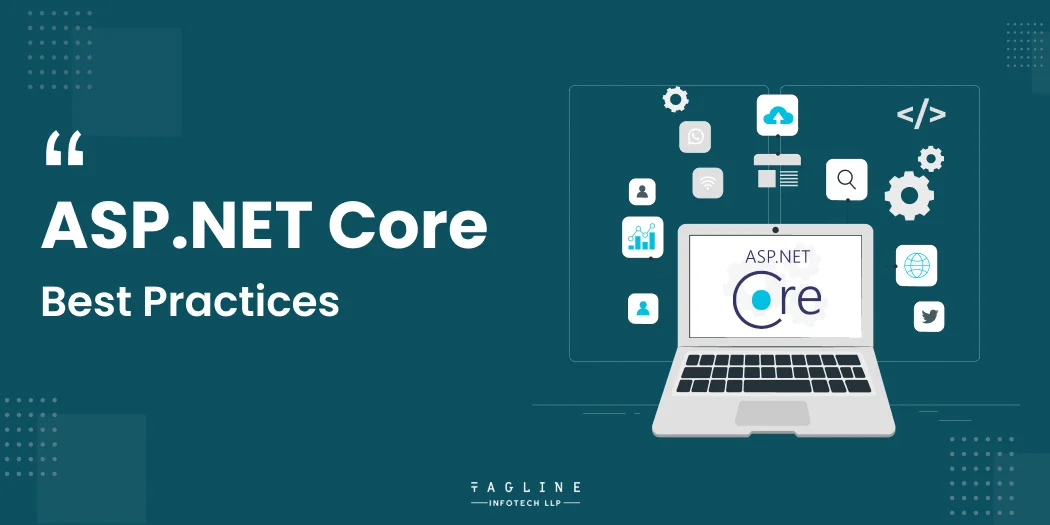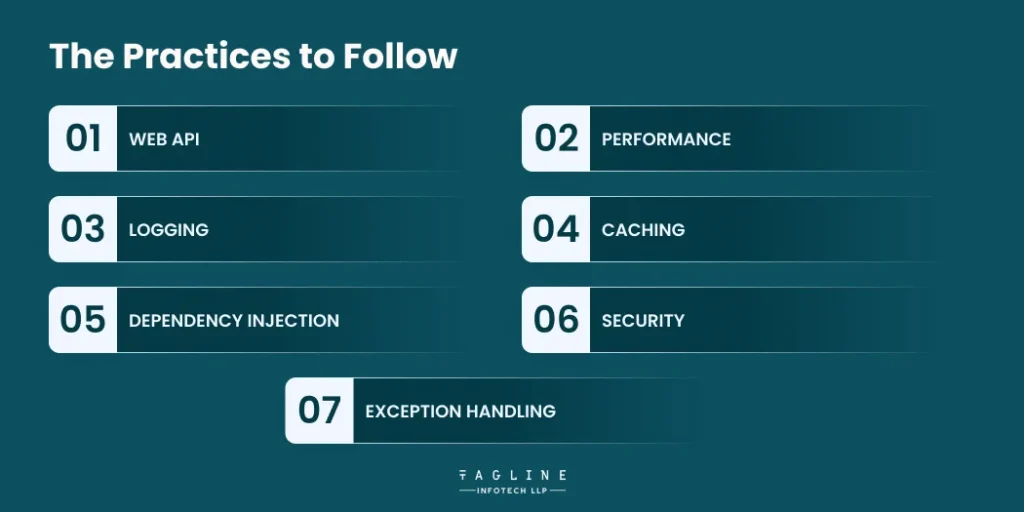Role of Python Libraries in Image Processing
October 30, 2025
Home >> ASP.Net >> ASP.NET Core Best Practices

Quick Summary
Developing an application is crucial because any issues can negatively impact business metrics. Therefore, development teams consistently adhere to best practices, as these guidelines significantly aid in utilizing any technology effectively. In this blog, you’ll discover .NET Core best practices that will help you build high-quality business applications, enhancing potential, productivity, and revenue. This guide covers the top practices, beneficial for novice, intermediate, and professional developers working within the .NET ecosystem.

When creating an ASP.NET Core application, the development team needs to focus on several important aspects: security, scalability, flexibility, and performance. If any of these areas are overlooked, the application might suffer, leading to potential business problems.
To avoid such issues, it’s crucial to follow .NET Core best practices. These practices help ensure that the application meets business needs and is built to be robust and durable. Let’s explore some straightforward tips and best practices for developing high-quality .NET Core applications.
1. Startup Class and Server Configuration
2. Data Access Layer
3. Environment-Based Settings:
4. Controllers:
To enhance your application’s performance by optimizing .NET Performance and its data access logic, it’s essential to consider how it interacts with the database. Most applications heavily rely on databases to retrieve, process, and display data, making it crucial to optimize this process.
Here are some suggestions to improve data access efficiency:
1. Asynchronous Data Access: Perform data access operations asynchronously, allowing multiple operations to occur concurrently. This asynchronous approach enhances responsiveness and scalability.
2. Minimize Unnecessary Data Retrieval: Retrieve only the data required for immediate use, avoiding unnecessary fetching of data in advance. This practice helps reduce overhead and improves efficiency.
3. Non-Tracking Queries: When performing read-only operations in Entity Framework Core, use non-tracking queries. These queries avoid keeping track of changes to entities, reducing memory usage and improving performance.
4. Optimize LINQ Queries: Utilize aggregate and filter LINQ queries, such as `Where`, `Select`, and `Sum`, to perform filtering operations directly in the database. This approach minimizes data transfer between the database and the application, enhancing performance.
By implementing these practices, you can optimize your application’s data access logic, resulting in improved performance and responsiveness for users.
When building an ASP.NET or .NET Core application, it’s essential to follow .NET Best Practices by enabling logging and storing all entries on a separate server. This approach facilitates effective debugging and maintenance post-deployment. Ensure that the log structure includes the date, time, a brief description, and details about the component generating the log.
Additionally, implementing a consistent logging mechanism within the application offers several benefits, such as:
By adhering to these .NET Core practices and leveraging .NET Core features, you can enhance your application’s reliability and security.
In .NET Core development, implementing a caching mechanism is essential. This .NET Core feature significantly improves performance and enhances stability for all end-users while reducing the cost of transmitting large objects repeatedly. Following .NET Best Practices for caching can lead to a more efficient application.
In a .NET Core application, consider configuring the following types of caches:
– Distributed Caching
– In-Memory Caching
– Distributed Cache Tag Helper
– Cache Tag Helper
Moreover, if you’re building an ASP.NET Core application, include the response caching middleware with the following code:
“`csharp
public void ConfigureServices(IServiceCollection services)
{
services.AddResponseCaching();
services.AddRazorPages();
}
“`
By integrating these .NET Core practices, you can significantly boost your application’s performance.
Dependency Injection (DI) is an essential feature of ASP.NET development technology, aligning with .NET Best Practices. It helps create a loosely coupled application, enhancing reusability, maintainability, and testability throughout the application lifecycle.
To fully utilize .NET Core practices, utilize all three types of dependency injection—Constructor, Setter, and Interface-based—according to your requirements. This approach ensures robust object construction and facilitates dependency transmission when needed. Additionally, it allows each component to be tested in isolation, preventing impacts on other components.
Moreover, after software deployment, DI supports maintenance with its pluggable-replaceable functionality, a valuable .NET Core feature. Thus, incorporating dependency injection into your ASP.NET Core application is crucial.
Quick Tips for Dependency Injection
1. Prefer Constructor Injection: Ensures all dependencies are provided, making classes easier to test and manage.
2. Use Property Injection Sparingly: Best for optional dependencies.
3. Avoid Service Locator: Hides dependencies, complicating maintenance.
4. Manage Service Lifetimes: Choose the right lifetime (transient, scoped, singleton) for efficient resource use.
5. Keep Dependencies Minimal: Inject only necessary dependencies to keep classes focused and manageable.
Following these practices will help you effectively use dependency injection in .NET Core to create maintainable, testable, and flexible applications.
Best Practices for Security in .NET Core
Keeping your .NET Core applications secure is crucial to protect sensitive data and prevent attacks. Here are some easy-to-follow security practices:
Always encrypt sensitive data before sending it over the internet. Encryption turns data into a secure format that unauthorized people can’t read. Use modern encryption techniques to keep your data safe both during transmission and when stored.
SSL (Secure Sockets Layer) is essential for protecting data exchanged between your application and users’ browsers. SSL encrypts data in transit, preventing it from being intercepted by malicious actors. Always enforce HTTPS to ensure all communications are secure.
XSS attacks happen when attackers inject harmful scripts into web pages that others view. To stop XSS, always validate and clean all user inputs to remove any dangerous scripts. Use .NET Core’s built-in features to automatically encode HTML and protect against XSS.
SQL injection attacks occur when malicious input is used to manipulate SQL queries. Using LINQ (Language Integrated Query) in .NET Core helps prevent SQL injection by creating safe, parameterized queries that securely handle user input.
Summary of Security Practices
1. Encrypt Sensitive Data: Protect sensitive information during transmission and storage with encryption.
2. Use SSL: Enforce HTTPS to ensure all data exchanged between your application and users is encrypted.
3. Prevent Cross-Site Scripting: Validate and sanitize user inputs to protect against XSS attacks, and use .NET Core’s HTML encoding features.
4. Guard Against SQL Injection with LINQ: Use LINQ to generate secure, parameterized queries that protect against SQL injection attacks.
By following these practices, you can make your .NET Core applications much more secure and resilient against common threats and vulnerabilities. For the best security advice, consult team from Tagline Infotech, which has extensive experience in this domain.
Exceptions should be rare occurrences in your code because the catch-and-throw mechanisms are slower compared to other code flow patterns. According to .NET Best Practices, exceptions should not be used to regulate the flow of a program. Instead, you should carefully analyze your program’s logic to identify and resolve scenarios prone to exceptions.
Throw or catch exceptions only for unusual or unexpected conditions. To adhere to .NET Core practices, utilize application diagnostic tools such as Application Insights to identify common exceptions in your app and assess their performance. By following these guidelines and leveraging .NET Core features, you can enhance the efficiency and reliability of your application.
Developing high-quality .NET Core applications involves following important tips and techniques that enhance performance, security, scalability, speed, and stability. Always use the latest version of .NET Core to benefit from new features, better performance, and improved security. Implement caching to increase application speed and reduce server load by temporarily storing frequently accessed data. Utilize asynchronous programming to handle multiple tasks simultaneously, making your application more responsive and efficient. Apply dependency injection to create code that is easy to manage, test, and maintain. By adhering to these best practices, you can build robust, scalable, and secure .NET Core applications that meet stakeholder expectations and are delivered on time. Hire best .NET Developers from Tagline Infotech, a leading Custom Software Development Company.
Safeguarding your .NET Core application involves measures such as thorough validation of user input to prevent malicious attacks like code injection, encryption of sensitive data to protect against unauthorized access, implementation of robust authentication mechanisms, and vigilance against common security threats.
Dependency injection helps keep your app organized and easy to test by separating different parts and managing how they work together.
Managing errors in your .NET Core application involves employing robust error-handling mechanisms such as try-catch blocks to gracefully handle exceptions and logging to track errors for effective debugging and maintenance.
Enlisting dedicated .NET Core developers ensures access to expertise in the framework's features and best practices, leading to efficient development and implementation tailored to your project's requirements. Their specialized knowledge and experience help navigate technical challenges, ensuring the successful delivery and maintenance of your application.
Created with Solvase

Digital Valley, 423, Apple Square, beside Lajamni Chowk, Mota Varachha, Surat, Gujarat 394101
D-401, titanium city center, 100 feet anand nagar road, Ahmedabad-380015
+91 9913 808 2851133 Sampley Ln Leander, Texas, 78641
52 Godalming Avenue, wallington, London - SM6 8NW